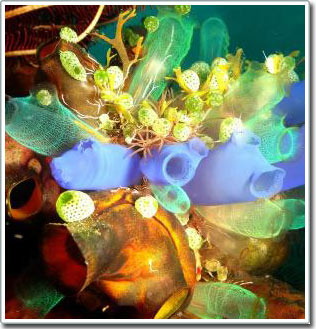Found a rare form of chlorophyll in a new bacterium that is sequenced
Researchers at Washington University (St. Louis) and Arizona State University recently sequenced the genome of a rare bacterium that is able to capture light energy through an even less type of chlorophyll. see more than this bacterium itself - chlorophyll d. Chlorophyll d absorbs a type of red ray with a long, almost infrared wavelength that the naked eye cannot see.
Therefore, the cyanobacterium Acaryochloris marina has no rivals among other plants or bacteria that compete with other light. As a result, its genome becomes too massive and complex compared to a cyanobacterium, including 8.3 million base pairs. This is the largest genome among the 55 cyanobacterium species in the world that have been sequenced so far. And this is also the first chlorophyll d chlorophyll-containing organism to be sequenced.

Sea squid and starfish.The Acaryochloris marina lives under the sea squid (one settles on the rocks just below the water).Cyanobacterium bacteria absorb ' red light ' through tissues of sea squid. (Photo: iStockphoto)
Dr. Robert Blankenship, professor of science and art Lucille P. Markey (University of Washington) and the principal investigator of the project, said that all Acaryochloris genes have been identified and analyzed. marina, the immediate goal is to find the enzyme that changes the chemical structure of chlorophyll d chlorophyll d, making it different from the two basic types (chlorophyll a and chlorophyll b) as well as different from 9 types of chlorophyll another continent.
Blankenship said: 'The process of synthesizing chlorophyll in any kind of organism is complicated, including 17 different steps. Perhaps near the end of the process, an enzyme that transforms the vinyl group into a formyl group creates chlorophyll d. This chemical form change is not available in any other chlorophyll molecule. '
Also according to Blankenship, he and his collaborators questioned some genes and will test them. They hope to be able to insert these genes into the organism that can only produce chlorophyll themselves. If the organism synthesizes chlorophyll d, the mystery of the chlorophyll d synthesis process will be revealed and the interesting things will eventually begin.
Blankenship and colleagues from two research institutes have published an article that explains their study on February 4, 2008 in The Proceedings of the National Academy of Sciences . The research was funded by the National Science Foundation with the participation of Japanese and Australian collaborators. Besides, there are 3 students and one alumni of Washington University as well as other single researchers participating in the project.
If plants and organisms that absorb heavy solar mass are implanted with chlorophyll d production genes, they will become solar energy production and storage plants . Suppose a 7-foot tall corn plant is paired with the chlorophyll d production gene at the base of the tree. While the rest of the corn plant synthesizes chlorophyll a, absorbing short wavelength light, the stump will absorb red light in the 710 nanometer range. The energy will be stored in the tree without having to compete with any part of the plant during photosynthesis because the remaining parts only have chlorophyll a. In addition, maize plants that carry the synthetic gene chlorophyll d can become a ' super-plant ' because of its superior solar energy extraction capacity.
The model is similar to the way Acaryochloris marina works in the South Pacific, especially in the great coral reefs in Australia. Discovered 11 years ago, the cyanobacterium lives symbiotic with a sponge-like organism commonly known as sea squid. The Acaryochloris marina lives beneath the sea squid (a species that settles on rocks located just below the water). Cyanobacterium bacteria absorb 'red light' through tissues of sea squid.
According to Blankenship, ' their genome is very delicate and massive. Acaryochloris can use a long wavelength of red light that no other species can imitate . It never had to undergo a strong selection pressure, unlike other bacteria. Living in such an environment facilitates it to develop an amazing genome. '
Blankenship said that once a gene that causes chemical changes in the last step and implanted into other plants or organisms, it can increase 5% of the light used by organisms.
Blankenship said: 'We now have the genetic information of a unique organism that produces the kind of pigment that no other creature can do. Although we do not know the role of all genes, we are also beginning to conduct analysis. Once we have found an enzyme that catalyzes the chlorophyll d synthesis and implements it into other organisms, we will study to expand the range of useful radiation for photosynthesis. '
- This bacterium will be the world's new energy source
- Detection of organisms containing chlorophyll but not photosynthesis
- Found traces of new forms of iron from the Antarctic universe
- Sea slug: Calling is a child or a tree?
- Detects sweet and sweet properties of Salmonella and its ability to cope with this bacterium
- Japan found a huge source of rare earth in the sea
- Microorganisms found in Kamchatka help treat tumors
- What if our bodies can synthesize food like plants?
- Why are leaves green?
- Found rare rare dragon in 5 Croatian caves
- Contact with dogs helps children reduce their risk of asthma
- Found minerals in cosmic dust in Scotland
 Surprised: Fish that live in the dark ocean still see colors
Surprised: Fish that live in the dark ocean still see colors Japan suddenly caught the creature that caused the earthquake in the legend
Japan suddenly caught the creature that caused the earthquake in the legend A series of gray whale carcasses washed ashore on California's coast
A series of gray whale carcasses washed ashore on California's coast Compare the size of shark species in the world
Compare the size of shark species in the world